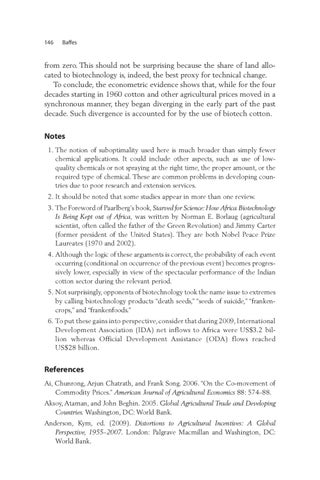146
Baffes
from zero. This should not be surprising because the share of land allocated to biotechnology is, indeed, the best proxy for technical change. To conclude, the econometric evidence shows that, while for the four decades starting in 1960 cotton and other agricultural prices moved in a synchronous manner, they began diverging in the early part of the past decade. Such divergence is accounted for by the use of biotech cotton.
Notes 1. The notion of suboptimality used here is much broader than simply fewer chemical applications. It could include other aspects, such as use of lowquality chemicals or not spraying at the right time, the proper amount, or the required type of chemical. These are common problems in developing countries due to poor research and extension services. 2. It should be noted that some studies appear in more than one review. 3. The Foreword of Paarlberg’s book, Starved for Science: How Africa Biotechnology Is Being Kept out of Africa, was written by Norman E. Borlaug (agricultural scientist, often called the father of the Green Revolution) and Jimmy Carter (former president of the United States). They are both Nobel Peace Prize Laureates (1970 and 2002). 4. Although the logic of these arguments is correct, the probability of each event occurring (conditional on occurrence of the previous event) becomes progressively lower, especially in view of the spectacular performance of the Indian cotton sector during the relevant period. 5. Not surprisingly, opponents of biotechnology took the name issue to extremes by calling biotechnology products “death seeds,” “seeds of suicide,” “frankencrops,” and “frankenfoods.” 6. To put these gains into perspective, consider that during 2009, International Development Association (IDA) net inflows to Africa were US$3.2 billion whereas Official Development Assistance (ODA) flows reached US$28 billion.
References Ai, Chunrong, Arjun Chatrath, and Frank Song. 2006. “On the Co-movement of Commodity Prices.” American Journal of Agricultural Economics 88: 574–88. Aksoy, Ataman, and John Beghin. 2005. Global Agricultural Trade and Developing Countries. Washington, DC: World Bank. Anderson, Kym, ed. (2009). Distortions to Agricultural Incentives: A Global Perspective, 1955–2007. London: Palgrave Macmillan and Washington, DC: World Bank.
